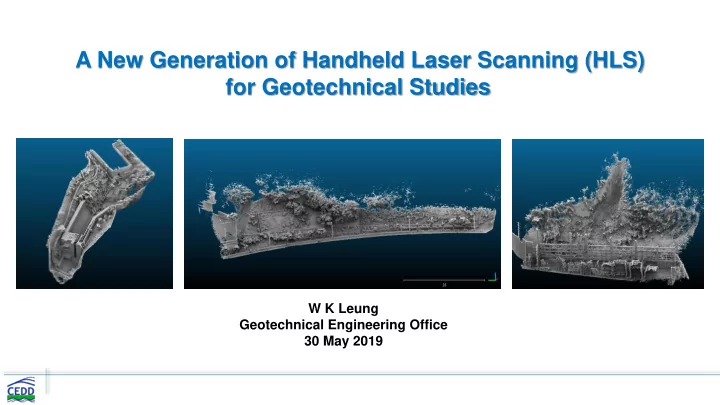

A New Generation of Handheld Laser Scanning (HLS) for Geotechnical Studies W K Leung Geotechnical Engineering Office 30 May 2019
Remote Sensing Techniques Photogrammetry (Aerial Unmanned Aerial Air-borne Light Detection and Photographs, Satellite Imagery) Vehicles (UAV) Ranging (LiDAR) InSAR Handheld Laser Terrestrial Laser Mobile Laser Scanning Scanning (HLS) Scanning (TLS) (MLS) 2
Light Detection And Ranging (LiDAR) First return from tree top (non-ground point) 1st (and only) return from ground Second return from branches (non-ground point) Last return from ground (ground point) 3
Handheld Laser Scanner Handheld Laser Scanner (Previous Model) (Current Model) Laser Spring Scanner Head Data- Battery Cable Camera logger • Measurement range: 30 m or 100 m Laser Scanner Data-logger • 300,000 measurement points/second Head • Scan range noise: 10 - 30 mm 4
Data Acquisition SLAM – Simultaneous localisation and mapping: • 2-D time of flight of laser pulses • Inertia measurement unit at scanner head to give the orientation • Mapping using the point cloud captured in the previous 5 seconds • Use features on the environment to register data • Output - Point cloud & trajectory • Align the data without the need for external control to produce a highly accurate 3-D point cloud of the area surveyed 5
Data Review Control upper and lower cap of point cloud Real-time images through smartphone or tablet 6
7
Capabilities of HLS • 3-D models (DSM & DTM) • Site records • Plotting of cross-sections, dimension measurement & volume estimation 8
Applications: Emergency Landslide Mapping Before urgent repair works After urgent repair works 9
HLS for mapping of natural terrain landslides: Supplement the data collected by UAV, especially at landslide trail where there are vegetation. For site measurements and record of channelization ratio 10
Applications: Mapping of As-built Condition Rigid Barrier at Pokfulam Road (Feature No. 11SW-A/ND52) Applications: Tree dimensions 11
Applications: Rock Joint Mapping Laser Scanning Point Cloud Plane Fitting 68 ° /236 ° 88 ° /160 ° 87 ° /329 ° Joint Measurement 12
Method for Geo-referencing • At least 3 reference points • Only required if actual location is important 13
Accuracy Checks - Weather Check (Feature No. 11NW-D/C 90) No Rain Light Rain Medium Rain 14
Accuracy Checks - Brightness Check (Feature No. 11SW-D/C465) Daytime Night time 15
Accuracy Checks - Dimension Check (t-test) No. of Site Setting Scans Natural Terrain 3 Rigid Barrier 2 Flexible Barrier 2 Retaining Wall 2 Soil Slope (Hard Surface) 1 Soil Slope (Vegetated Surface) 2 Rock Slope 2 Garden 3 Seminar Room 1 Tunnel 2 TOTAL 20 16
Dimension Checks (Daytime VS Night time) The percentage error of the 20 scans in daytime (3 measurements per scan): 1.54, 1.28, 0.76, 0.74, 0.73, 0.89, 0.25, 0.70, 1.54, 0.31, 1.65, 1.10, 0.70, 1.20, 0.67, 0.23, 0.91, 1.11, 0.47, 0.94 The percentage error of the 20 scans in night time (3 measurements per scan): 2.71, 1.73, 0.87, 0.33, 1.09, 0.90, 0.56, 0.92, 1.45, 0.96, 0.47, 0.77, 0.78, 0.40, 0.53, 0.63, 1.21, 0.72, 0.49, 1.02 t-test H 0 (Null hypothesis): the % error for daytime and night time are NOT significantly different. H 1 (Alternative hypothesis): the % error for daytime and night time are significantly different. Similar statistical analysis carried Degree of freedom: (20-1) + (20-1) = 38 out for scanning under fine Critical value (5% significance level) = 2.024 weather and rainy weather. t-value = 0.266 t-test suggested that there was no Conclusion: significant variation in the HLS performs equally well percentage errors. t-value < critical value under different brightness Null hypothesis is NOT rejected ! and weather conditions. 17
Key Advantages of HLS peedy Quick for data review and processing andy Lightweight and easy to carry ccurate Adequate for most geotechnical applications obust Able to be used at night time and in raining conditions ortable Applicable to remote sites/difficult terrain 18
Potential Application Areas • Emergency inspection and landslide mapping • Projects requiring 3-D models and topographic data • Unauthorised works (e.g. capturing of field situation) • Site progress, amount of excavation/filling • As-built construction records (e.g. completed LPMit works) • Rock joint measurement • Coupled with other remote sensing techniques, for example, photogrammetry, UAV etc. S peedy H andy A ccurate R obust P ortable 19
Recent Increase in Measurement Range 20
Recommend
More recommend